METECC LED Lamp Investigation
It started with a floor standing lamp
In July of 2010, Peter and Sharon Metcalfe, of the "EMC and LVD testing, training and consultancy" company, METECC, came across a lamp that seemed to advertise its complete lack of compliance with the EMC Directive.
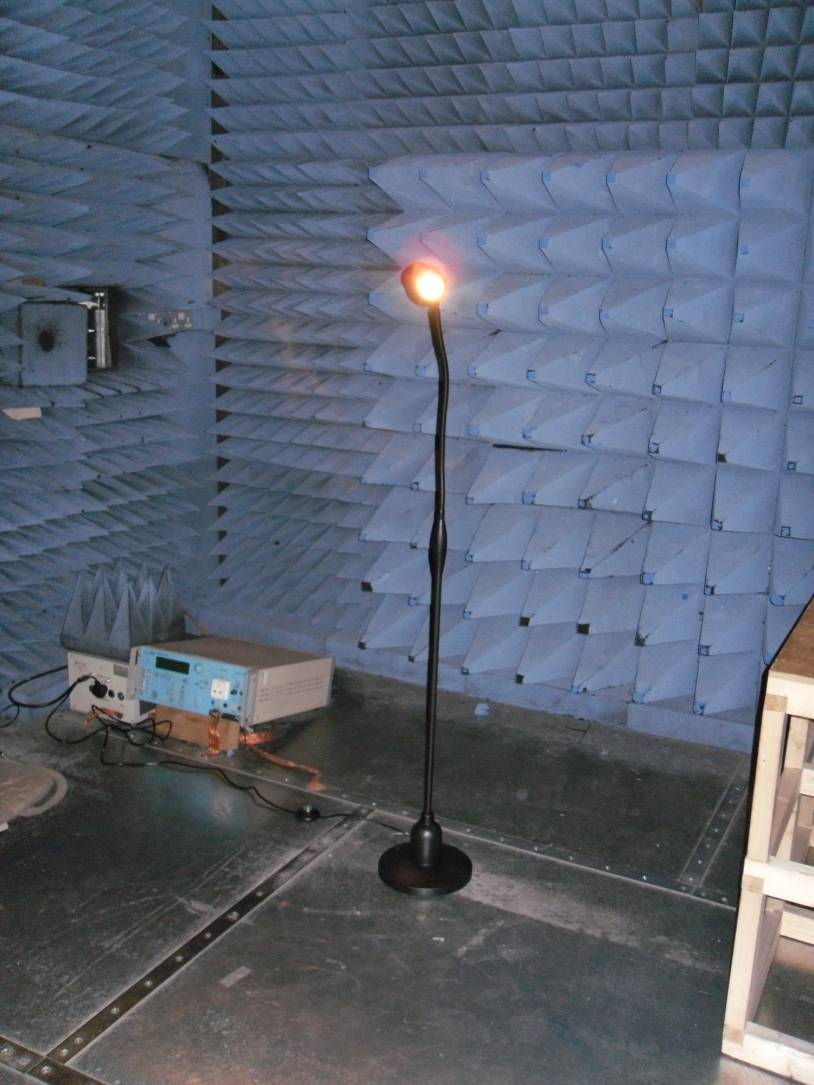 © METECC - Used with permission |
"We are now offering our most popular light fitted with the latest LED technology.
Only uses 5W of energy. This LED model will interfere with DAB broadcasts." |
Hardly an incentive to purchase a DAB-killing lamp!
The floor standing lamp was fitted with a halogen lamp and powered from the mains. Inside the EMC test-chamber, the lamp was checked for radiated emissions to standardised test EN55022, Class B (domestic usage). The image below shows the result of the test for radiated emissions from 30MHz up to 1GHz. The worst case margin (marker 1) is only 12dB below Class B limits (red line). These emissions were subsequently traced to the 12V switched-mode power-supply.
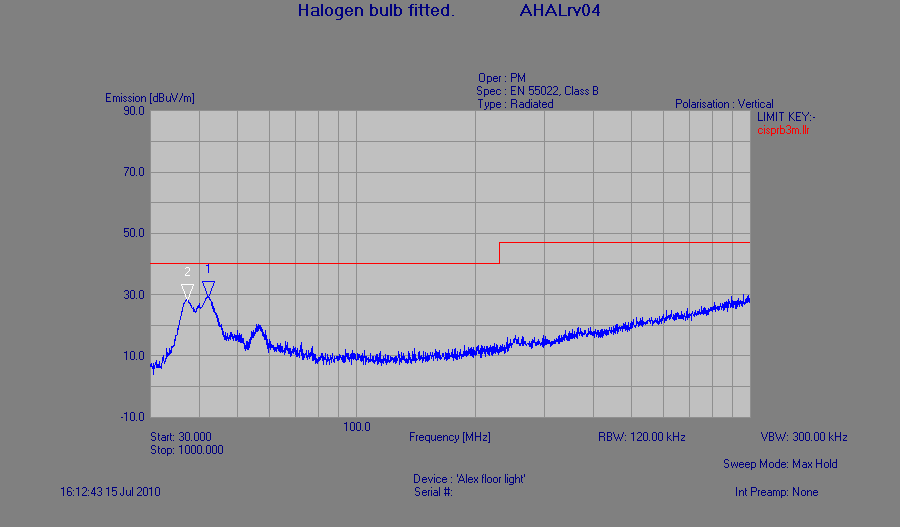
© METECC - Used with permission | Click the image for a larger view.
The halogen lamp was replaced with an Opti-LED 3.5W lamp and the radiated emissions were checked again. This time, the worst case margin is 15.78dB above the Class B limit (red line). The peaks around 100MHz would cause considerable interference to an 'FM Stereo' radio.
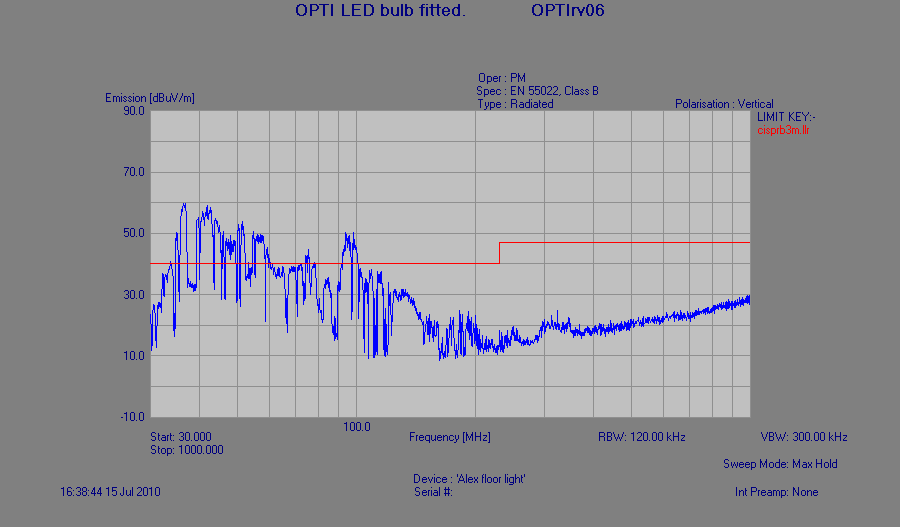
© METECC - Used with permission | Click the image for a larger view.
The lamp was replaced with a Philips 7W model and the radiated emissions were tested again. The worst case margin on this test is 7.11dB above the Class B limit (red line).
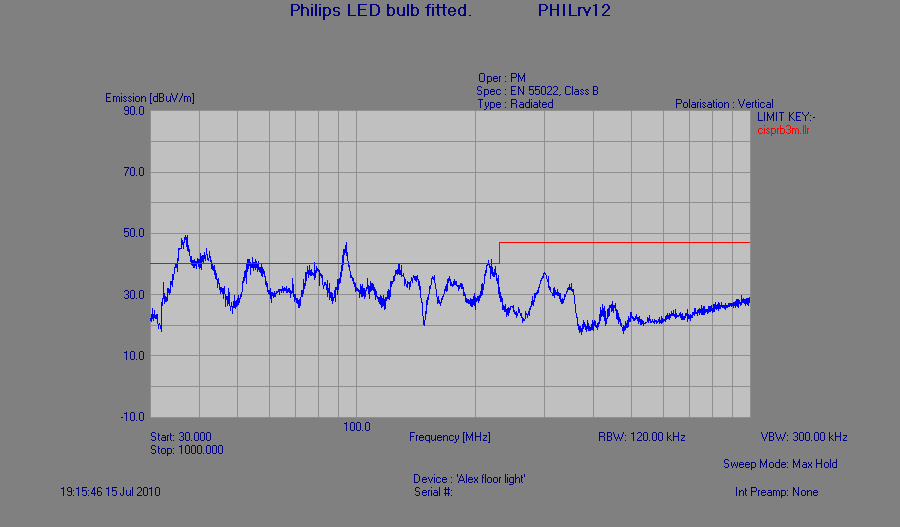
© METECC - Used with permission | Click the image for a larger view.
As a quick comparison, the following radiated emissions traces show the halogen lamp (red trace); Opti-LED 3.5W (cyan trace); Philips 7W (blue trace).
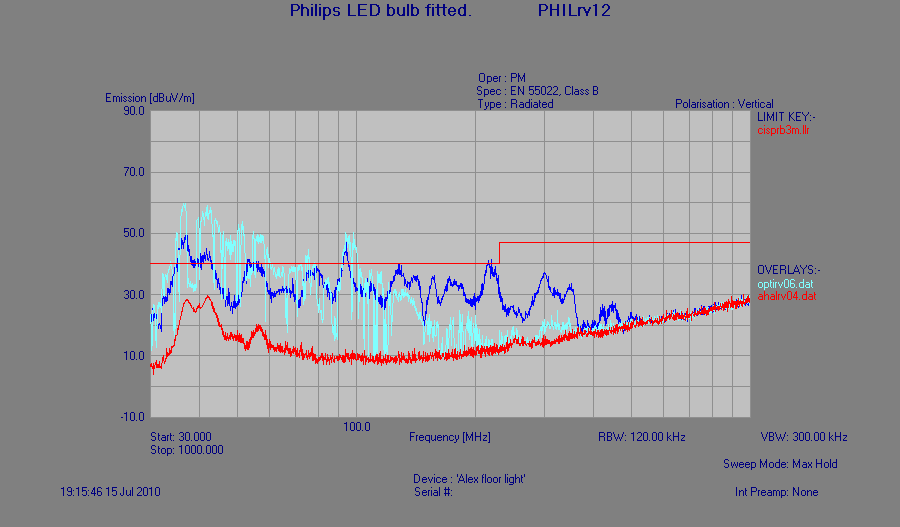
© METECC - Used with permission | Click the image for a larger view.
The halogen lamp was re-fitted and conducted emissions tests were carried out. Conducted emissions are typically measured between 150kHz and 30MHz. The Average detector was 9.51dB above Class B limits (red line) and the
 Quasi-Peak detector
was 8.54dB above Class B limits (yellow line). The halogen lamp should have been silent. The switched-mode power-supply used in the lamp was clearly non-compliant, but this pales into insignificance when
a buck-driven LED lamp was added in to the mix.
Quasi-Peak detector
was 8.54dB above Class B limits (yellow line). The halogen lamp should have been silent. The switched-mode power-supply used in the lamp was clearly non-compliant, but this pales into insignificance when
a buck-driven LED lamp was added in to the mix.
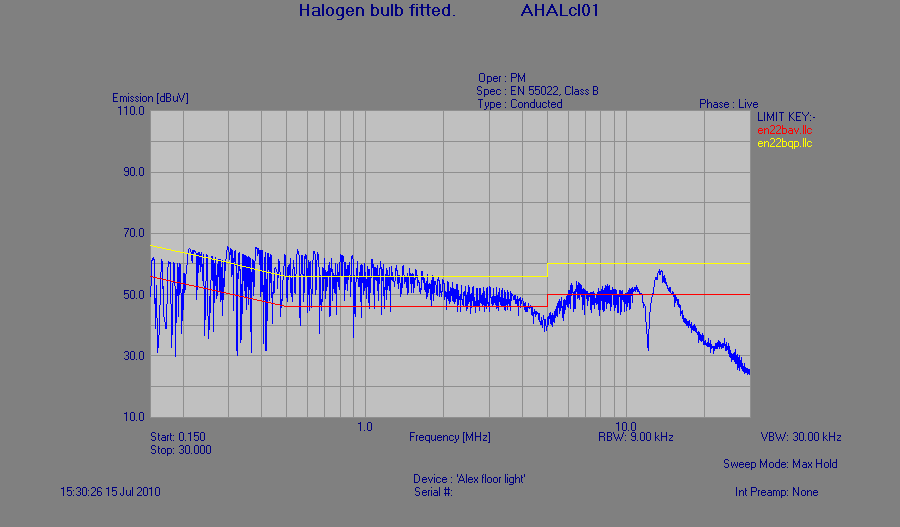
© METECC - Used with permission | Click the image for a larger view.
The halogen was swapped for the Opti-LED 3.5W lamp and the conducted emissions tests were repeated. The Average detector was 12.71dB above Class B limits (red line) and the Quasi-Peak detector was 7.57dB above Class B limits (yellow line).
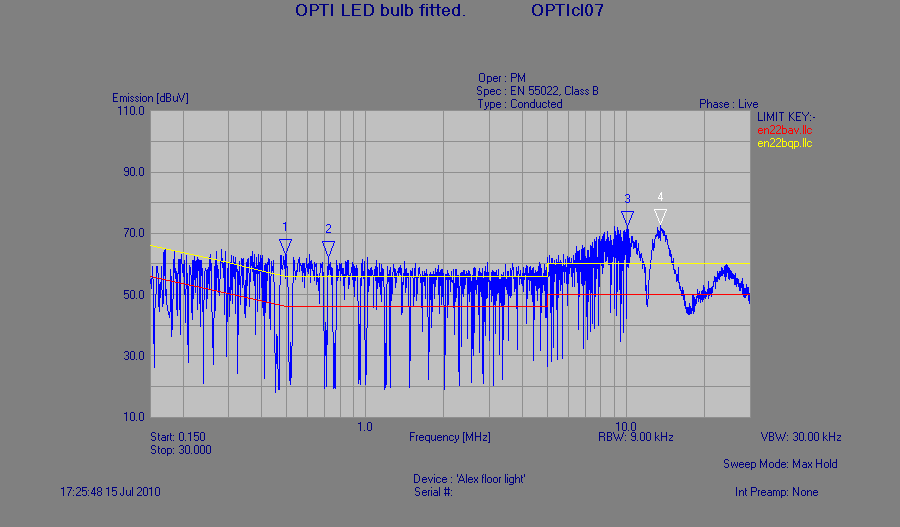
© METECC - Used with permission | Click the image for a larger view.
The Opti-LED 3.5W lamp was changed for the Philips 7W lamp and the conducted emissions tests were repeated. The Average detector was 15.69dB above Class B limits (red line) and the Quasi-Peak detector was 15.12dB above Class B limits (yellow line).
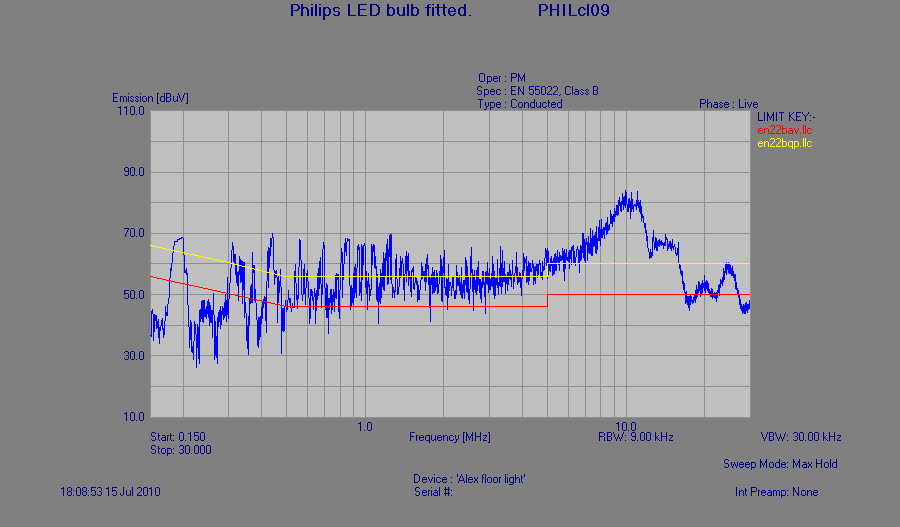
© METECC - Used with permission | Click the image for a larger view.
As a quick comparison, the following conducted emissions traces show the halogen lamp (red trace); Opti-LED 3.5W (cyan trace); Philips 7W (blue trace). The lower frequency emissions were attributed to the switched-mode power-supply, but note the large variation between lamp types around 10MHz.
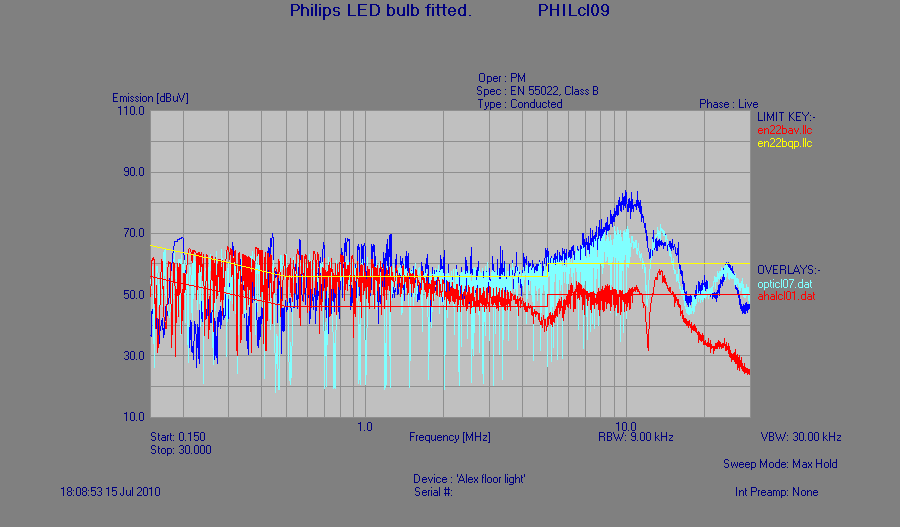
© METECC - Used with permission | Click the image for a larger view.
Is this indicative of all LED lighting? We decided to test some battery powered LED lights. All gave "noise floor" measurements; i.e. they did not create any radiated emissions.
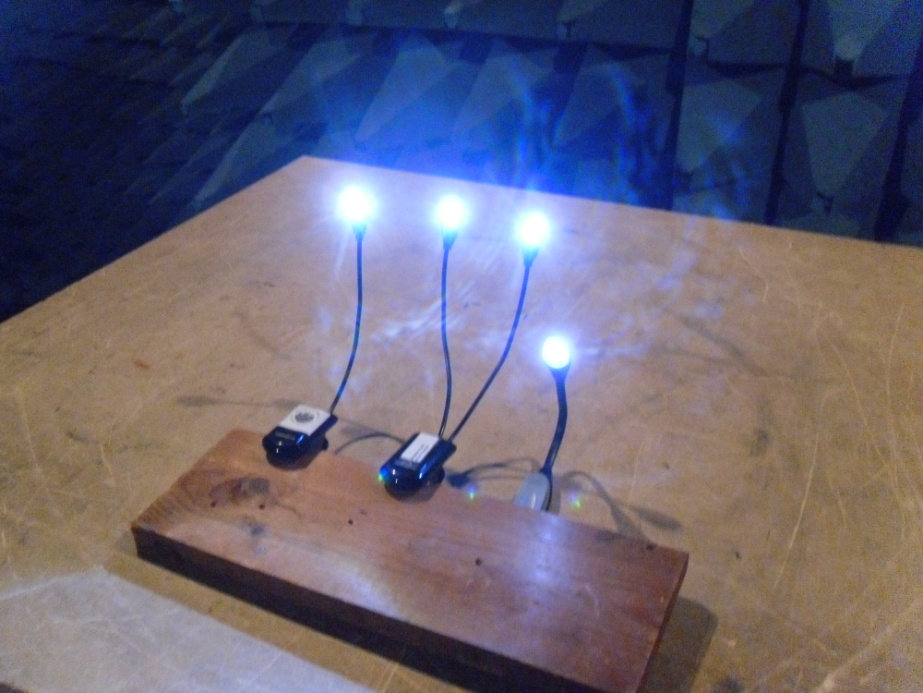
© METECC - Used with permission
Using a linear power supply (known to not create interference), we set about testing the lamp units via 300mm of twisted-pair wire:
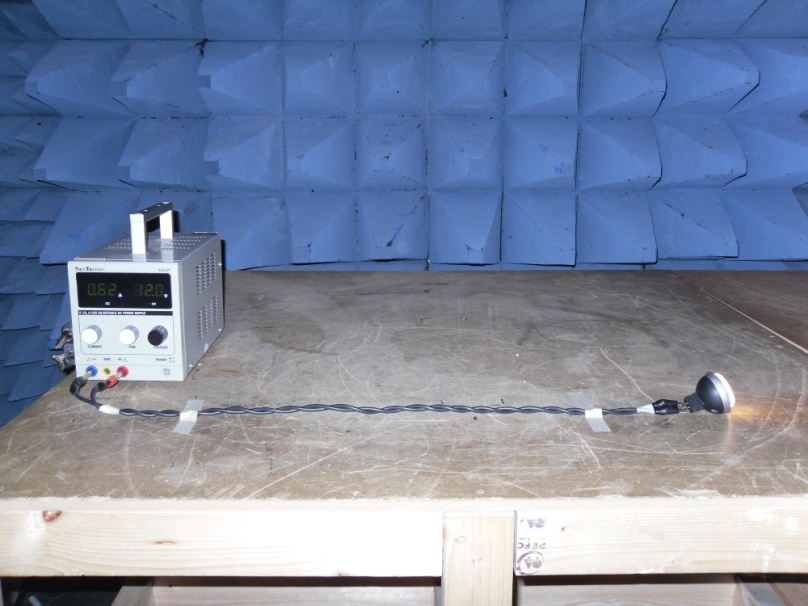
© METECC - Used with permission
The following radiated emissions traces show the halogen lamp (red trace); Opti-LED 3.5W (cyan trace); Philips 7W (blue trace). Neither LED lamp is particularly clean when compared to the halogen, and both are only just under Class B limits. The Philips lamp (blue trace) peaking around 220MHz could cause problems for DAB radios.
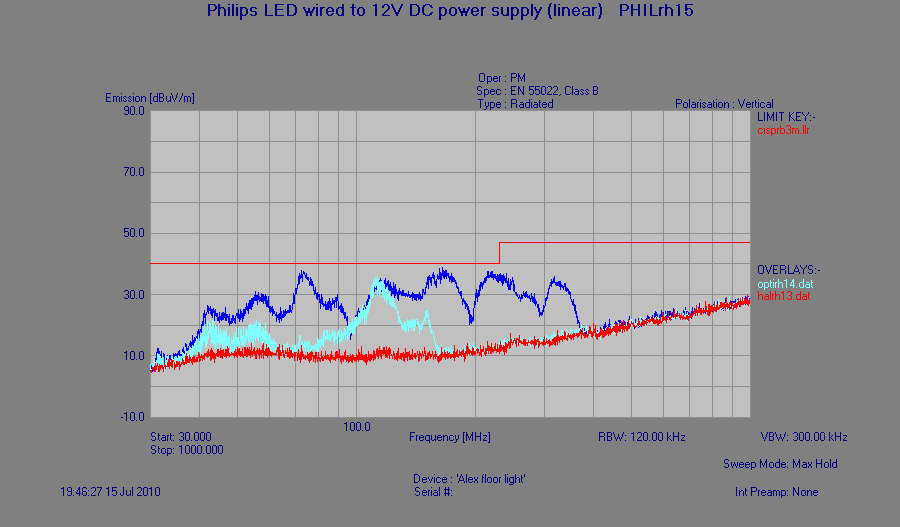
© METECC - Used with permission | Click the image for a larger view.
Time to disassemble the lamp:
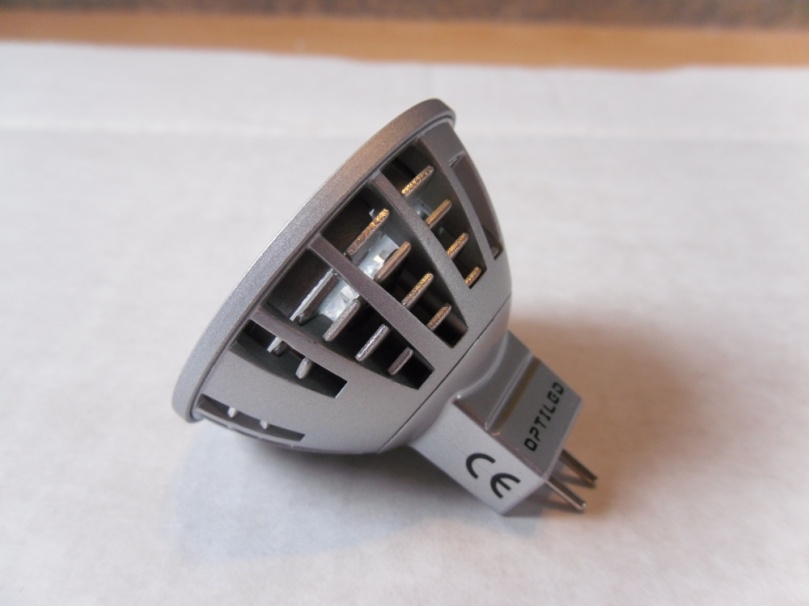 |
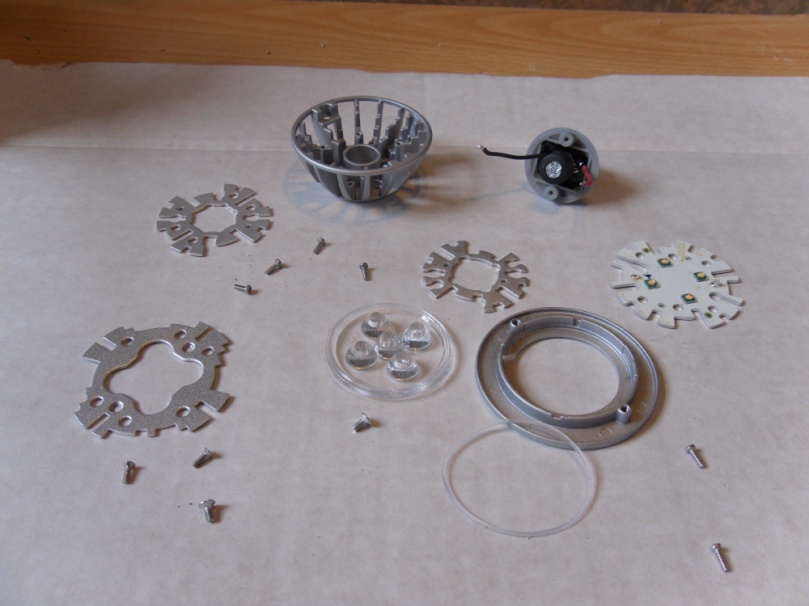 |
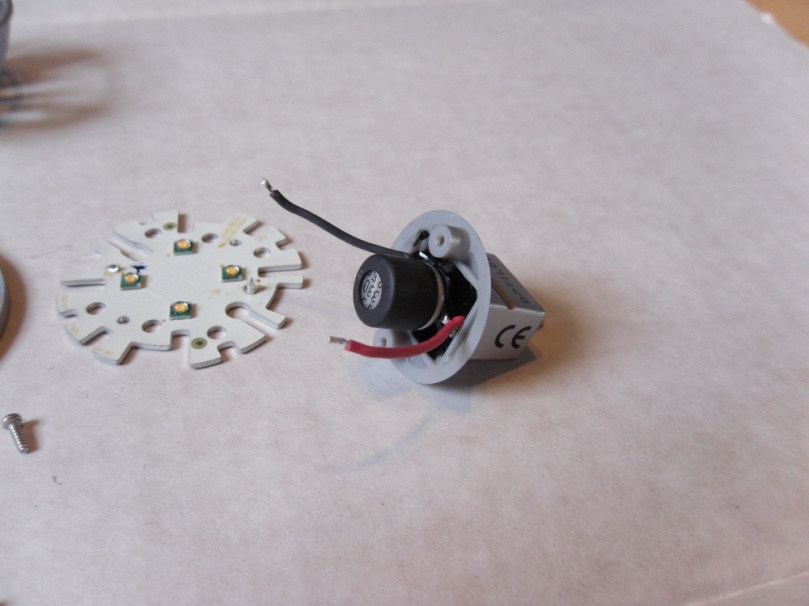 |
The following radiated emissions trace shows just the LED plate powered from the linear power supply. The AC/DC converter was left off for this test, and as we can see, only noise-floor emissions are seen. This proves, as we would expect, that the diodes do not create any detectable noise.
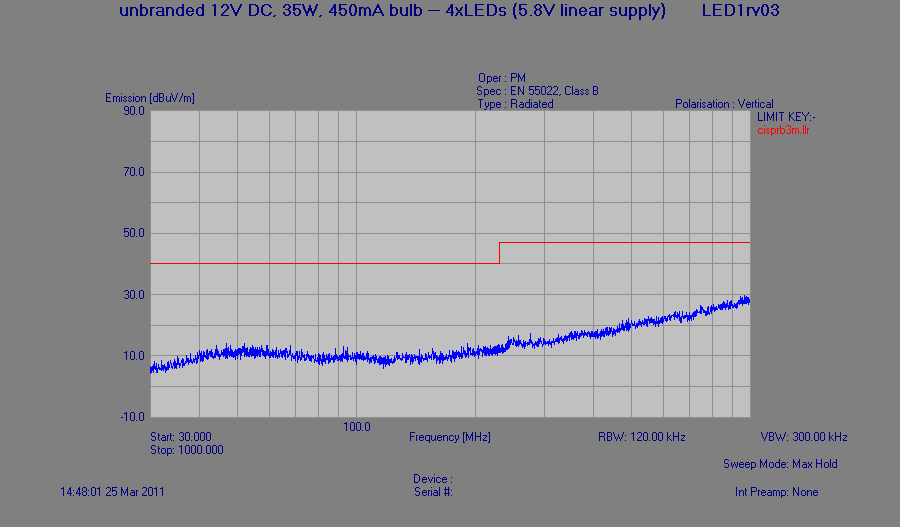
© METECC - Used with permission | Click the image for a larger view.
The following conducted emissions trace is for the Opti-LED 3.5W lamp fed with 12Vdc via a
 Line Impedance Stabilization Network
(LISN). The Average detector was 30.83dB above Class B limits (red line) and the Quasi-Peak detector was 20.30dB above Class B limits (yellow line). These emissions are clearly generated by a buck-driver
constant-current device used to regulate current to the LEDs.
Line Impedance Stabilization Network
(LISN). The Average detector was 30.83dB above Class B limits (red line) and the Quasi-Peak detector was 20.30dB above Class B limits (yellow line). These emissions are clearly generated by a buck-driver
constant-current device used to regulate current to the LEDs.
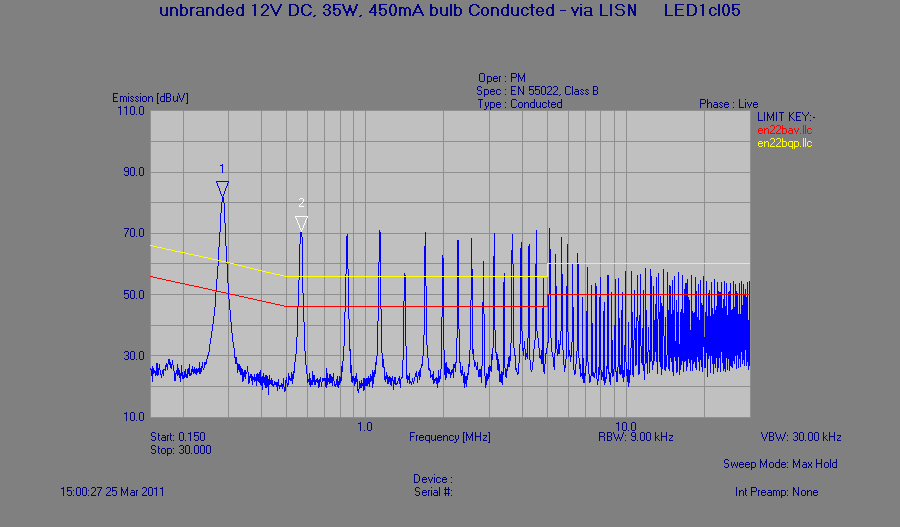
© METECC - Used with permission | Click the image for a larger view.
The following conducted emissions trace is for the Philips 7W lamp fed with 12Vdc via a LISN. The Average detector was 57.74dB above Class B limits (red line) and the Quasi-Peak detector was 61.64dB above Class B limits (yellow line). Note: Overload of the test equipment was detected, so linearity of readings could not be guaranteed.
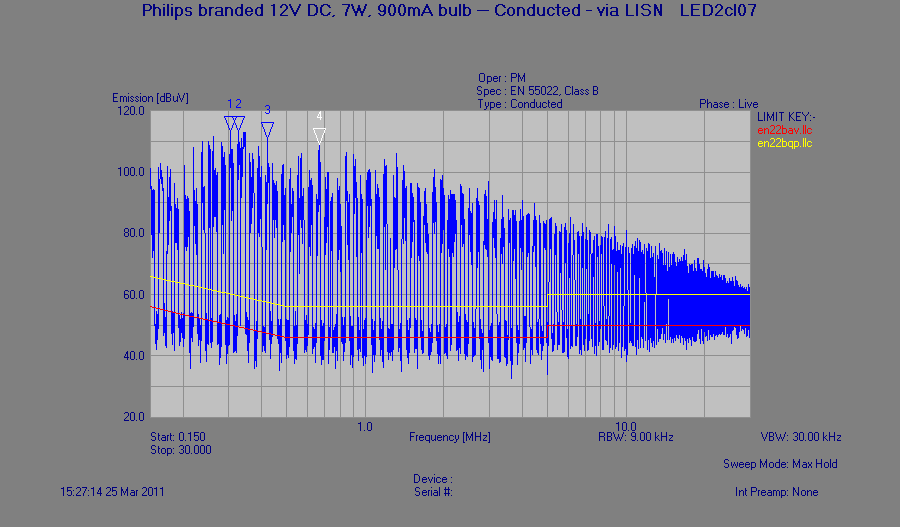
© METECC - Used with permission | Click the image for a larger view.
More lamps
We decided to purchase and test other lighting solutions, including mains-powered lamps (where they might include their own power-regulator).
Deltech 4W MR16 12V ac/dc (30W Halogen equivalent)
Radiated emissions:
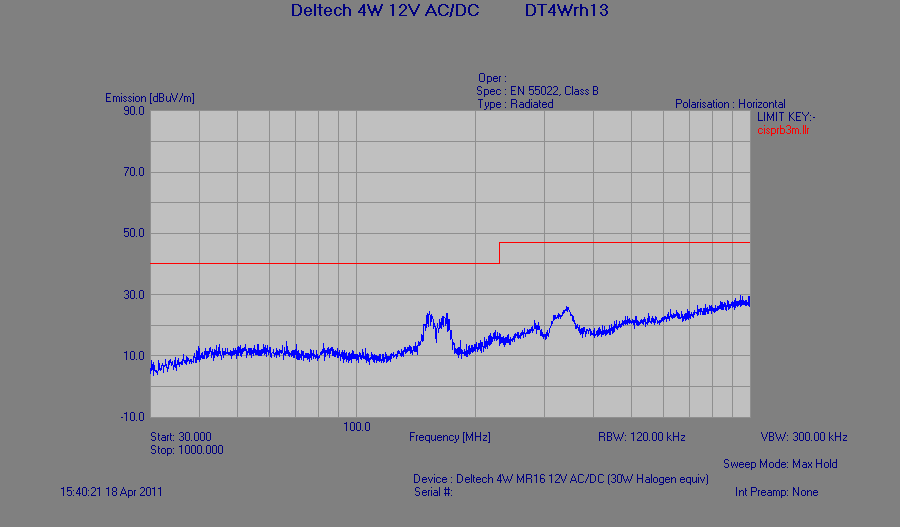
© METECC - Used with permission | Click the image for a larger view.
Conducted emissions:
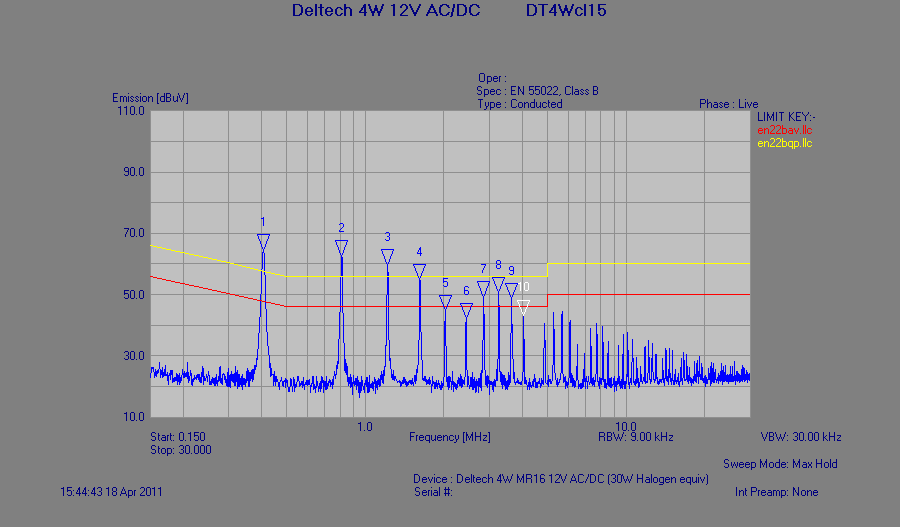
© METECC - Used with permission | Click the image for a larger view.
GE 1W (28 lumen) White GU10 230-240Vac
Radiated emissions:
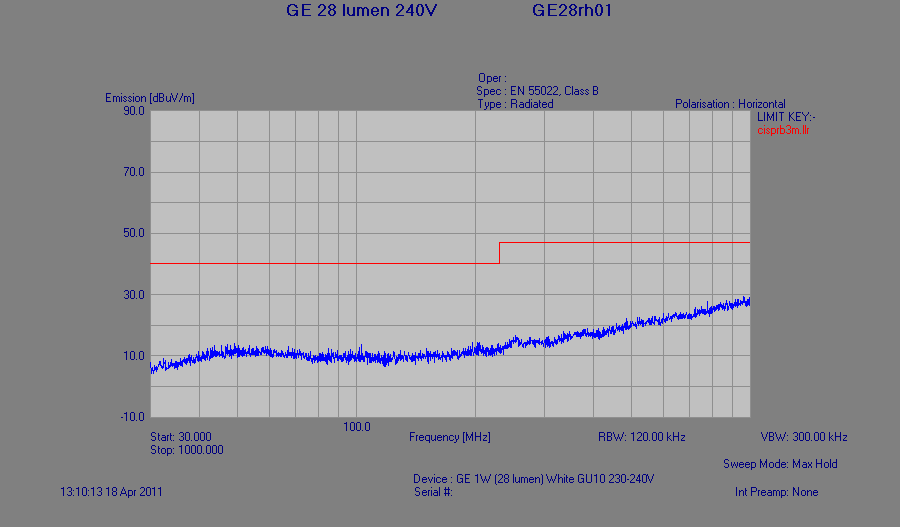
© METECC - Used with permission | Click the image for a larger view.
Conducted emissions:
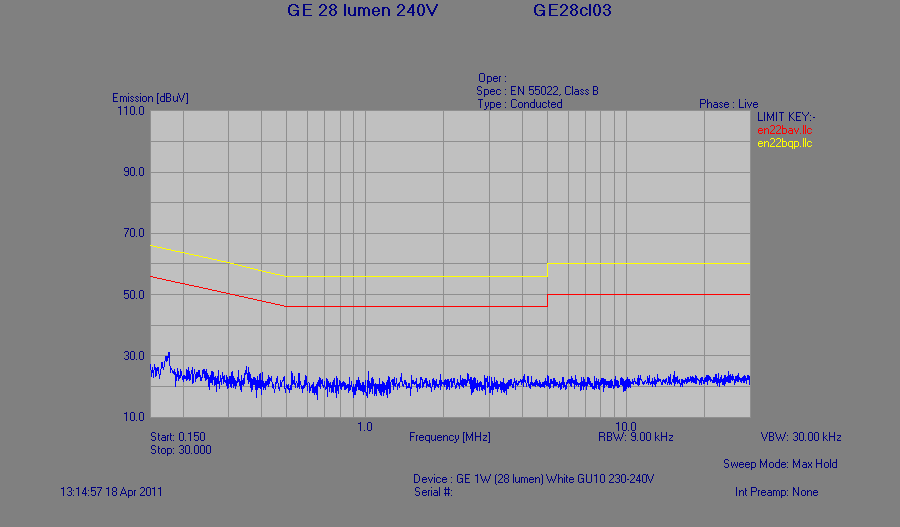
© METECC - Used with permission | Click the image for a larger view.
GE 4W (225 candela) White GU10 240Vac
Radiated emissions:
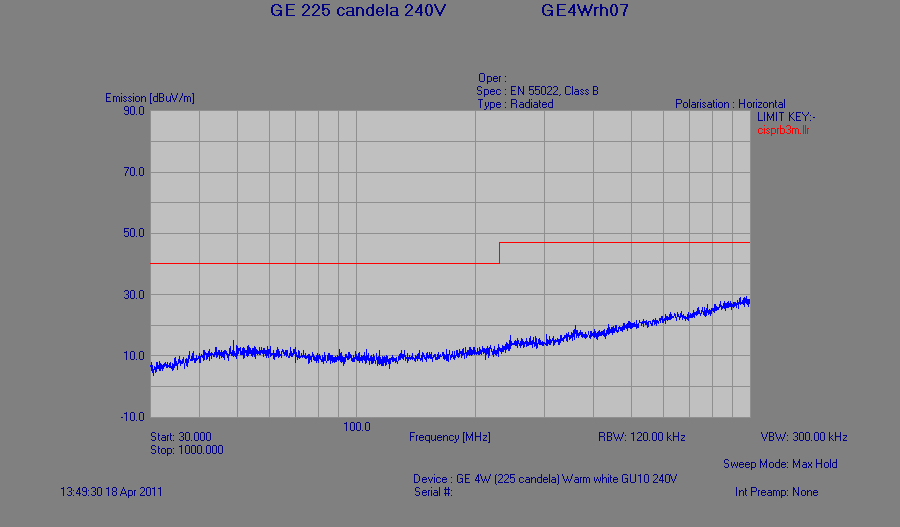
© METECC - Used with permission | Click the image for a larger view.
Conducted emissions:
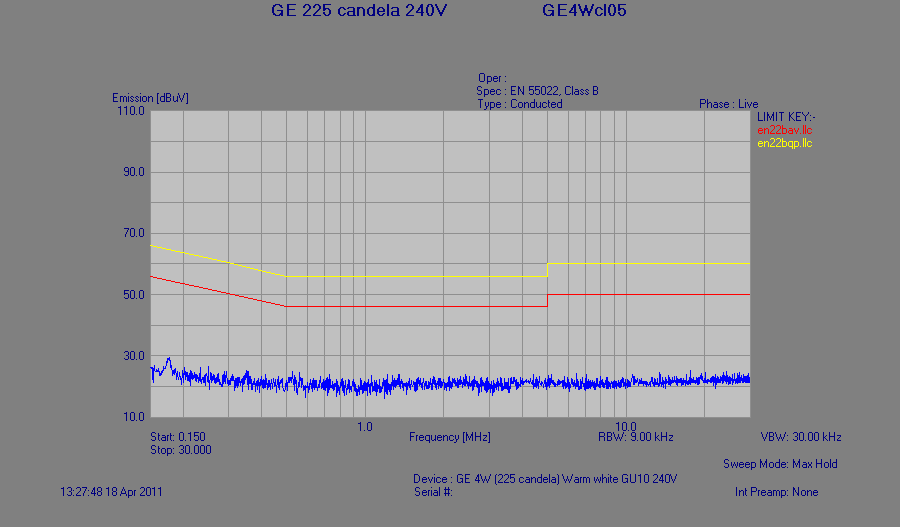
© METECC - Used with permission | Click the image for a larger view.
Alpha 1.3W (8W incandescent equiv) GU10 240V
Radiated emissions:
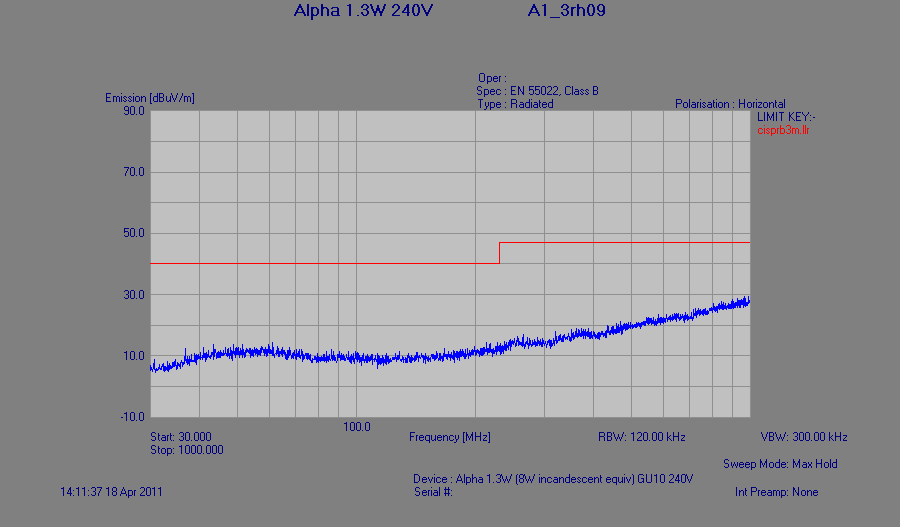
© METECC - Used with permission | Click the image for a larger view.
Conducted emissions:
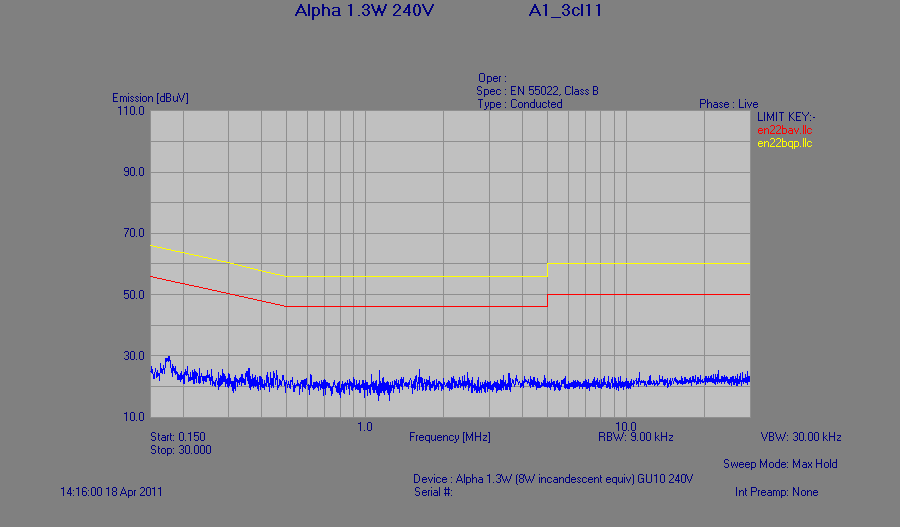
© METECC - Used with permission | Click the image for a larger view.
18W 1200mm 230V Strip Light
Conducted emissions:
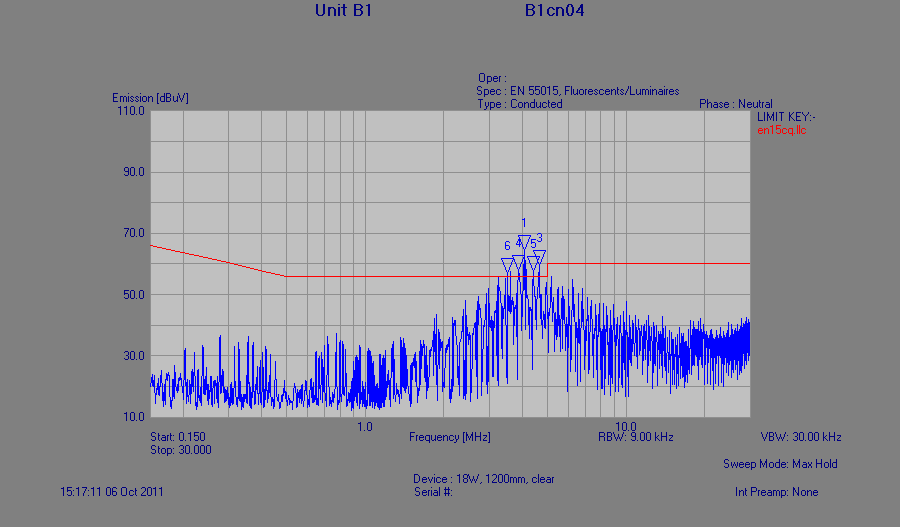
© METECC - Used with permission | Click the image for a larger view.
This unit FAILS the conducted Quasi-Peak requirement by 7.37dB (marker #1). 9-150kHz conducted, and 30-300MHz radiated emissions, are all well within requirements.
Tim Williams (of  Elmac Services)
has been carrying out independent investigations on 240Vac lamps and has found all to be compliant for conducted emissions, but have quite different characteristics, especially below 150kHz.
Elmac Services)
has been carrying out independent investigations on 240Vac lamps and has found all to be compliant for conducted emissions, but have quite different characteristics, especially below 150kHz.
We, along with Keith Armstrong (of  Cherry Clough Consultants),
are concerned that we may have a misunderstanding of the EMC Standards and Regulations as lamp manufacturers appear to be under the misapprehension that only conducted emissions testing is required,
and then only for 230/240Vac units.
Cherry Clough Consultants),
are concerned that we may have a misunderstanding of the EMC Standards and Regulations as lamp manufacturers appear to be under the misapprehension that only conducted emissions testing is required,
and then only for 230/240Vac units.
We were recently informed by a company, who install studio equipment, that many professional recording studios have banned the use of "energy efficient" lighting, in particular LED lighting!
In summary
The Good
- The LEDs themselves are, as expected, benign and do not emit.
- Available 240Vac units appear to be compliant (at least above 150kHz).
- If 240Vac lamps do employ switching circuitry then the technology and/or filtering used appears to be adequate for compliance.
- Low voltage units employing LEDs only (torches, panel indicators, etc.) are no problem.
- Even some low voltage units employing switching circuitry are no problem.
The Bad
- Some low voltage LED units employing electronic devices (constant current sourcing?) exhibit unacceptable conducted emissions.
- The current trend towards "energy efficient" lighting means that LED usage will become much more widespread.
- These units are often installed as part of a low voltage distribution system which could extend over an entire building.
- Reports seem to show that the lighting industry does not appreciate the need for low voltage device emissions testing.
- Research into better ac/dc converters and constant current devices, along with adequate filtering, is essential.
- Problems are beginning to emerge in areas other than domestic lighting.
The Ugly
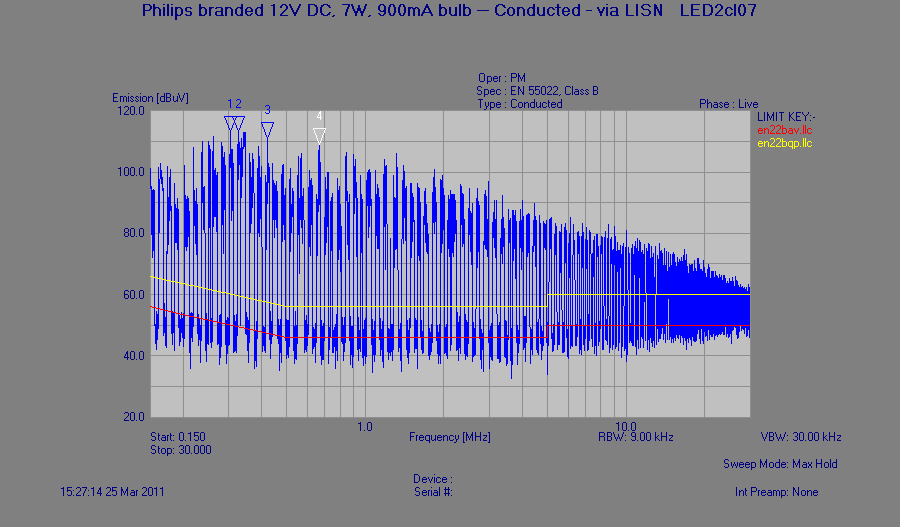
© METECC - Used with permission | Click the image for a larger view.
What will be the impact on the power distribution network, and the radio spectrum when you consider how many LED lights a household may have?
And this is where our investigation might have stopped...
We were demonstrating these findings at the EMCUK trade show in October 2011 when we suddenly found one of our lamps, which was previously thought to have few emissions, suddenly went way above the limit! Tracing the problem we noticed that the voltage supply to the lamp had drifted off 12V. This led us to a whole new line of investigation, and by now, other people, including Keith Armstrong, had lent us more LED lamps to look at.
Unbranded LED MT16 6W
Radiated emissions are well under the limit with the voltage set to exactly 11V:
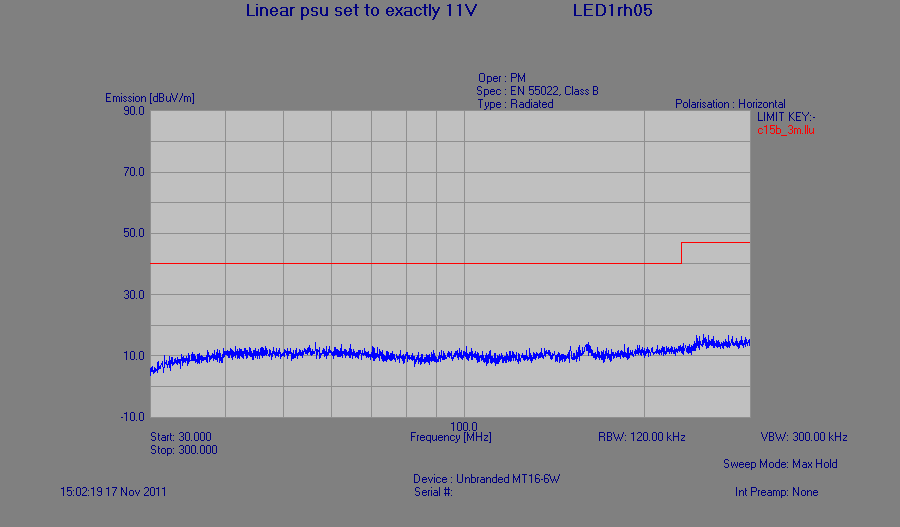
© METECC - Used with permission | Click the image for a larger view.
No radiated emissions problems at exactly 12V.
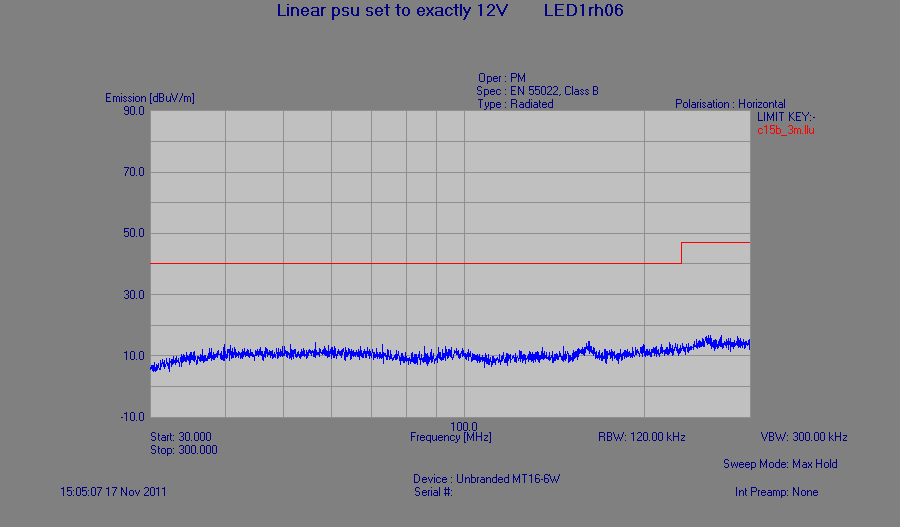
© METECC - Used with permission | Click the image for a larger view.
Radiated emissions "slightly" above the limit with the voltage set to exactly 13V.
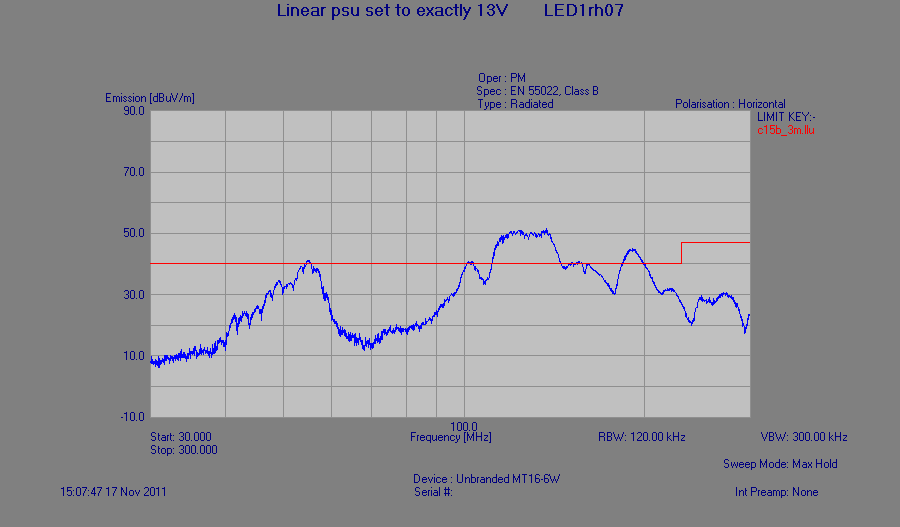
© METECC - Used with permission | Click the image for a larger view.
Radiated emissions with comparison overlays for voltages at 11V (blue trace), 12V (cyan trace) and 13V (red trace).
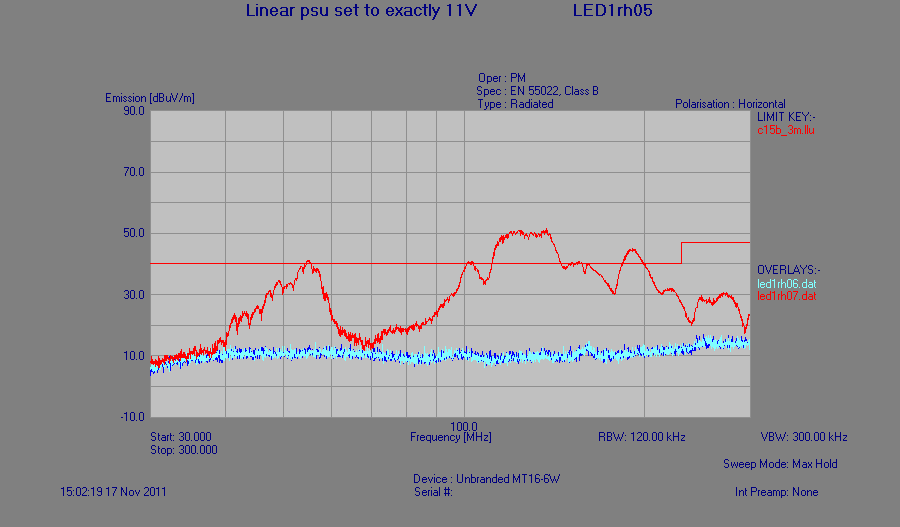
© METECC - Used with permission | Click the image for a larger view.
Conducted emissions show no problems at 11V:
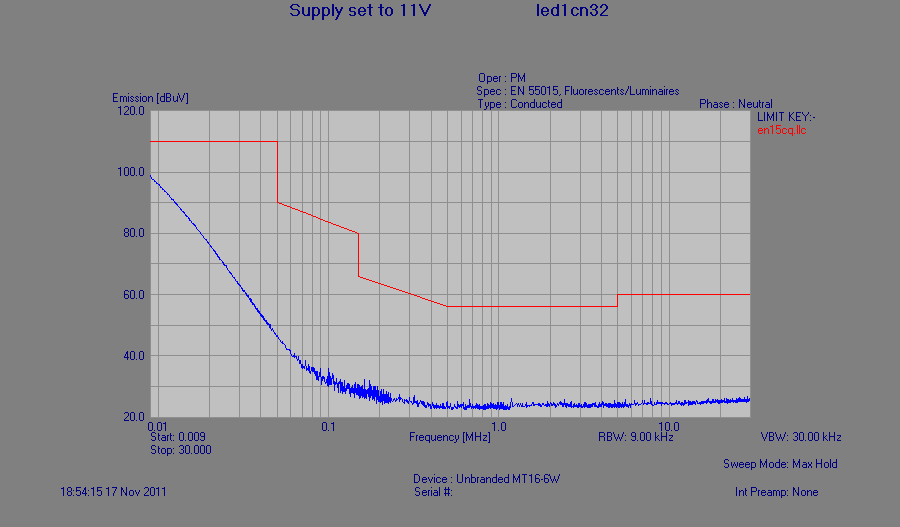
© METECC - Used with permission | Click the image for a larger view.
Conducted emissions show no problems at 12V:
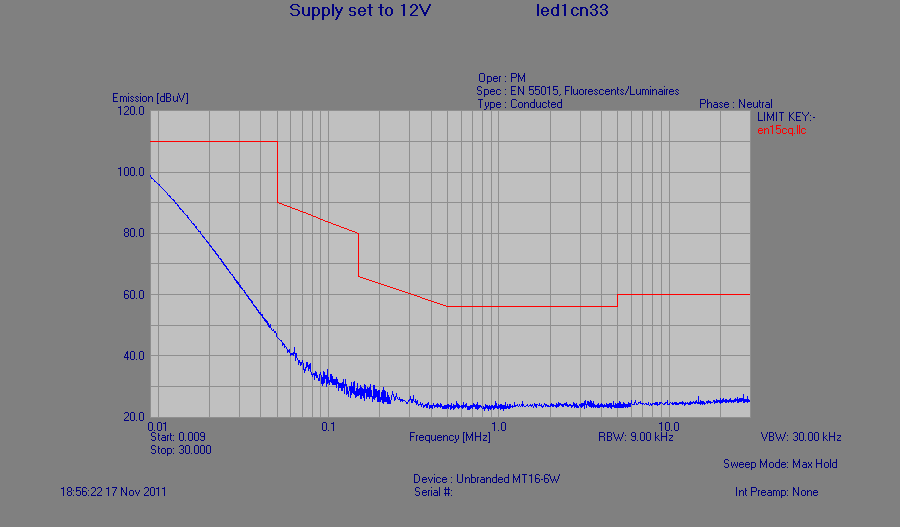
© METECC - Used with permission | Click the image for a larger view.
Conducted emissions at 13V - not quite noise floor!
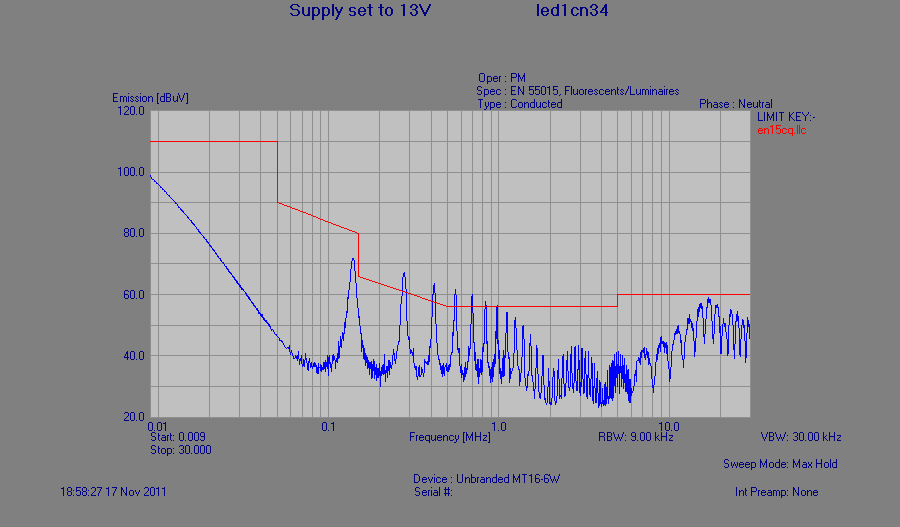
© METECC - Used with permission | Click the image for a larger view.
Conducted emissions with comparison overlays for voltages at 11V (blue trace), 12V (cyan trace) and 13V (red trace).
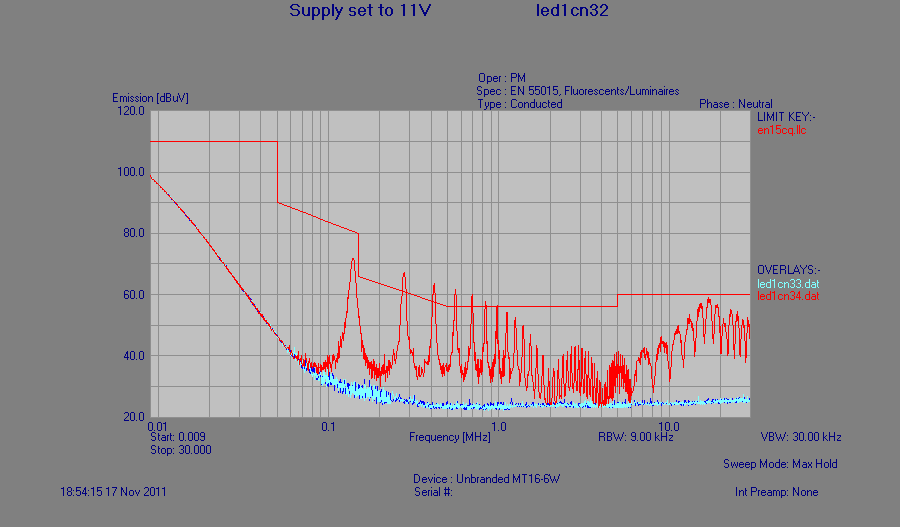
© METECC - Used with permission | Click the image for a larger view.
Not all LED lamps exhibit this poor behaviour - some are poor at all voltages.
Un-branded 12V ac/dc LED lamp
Radiated emissions with comparison overlays for voltages at 11V (blue trace), 12V (cyan trace) and 13V (red trace).
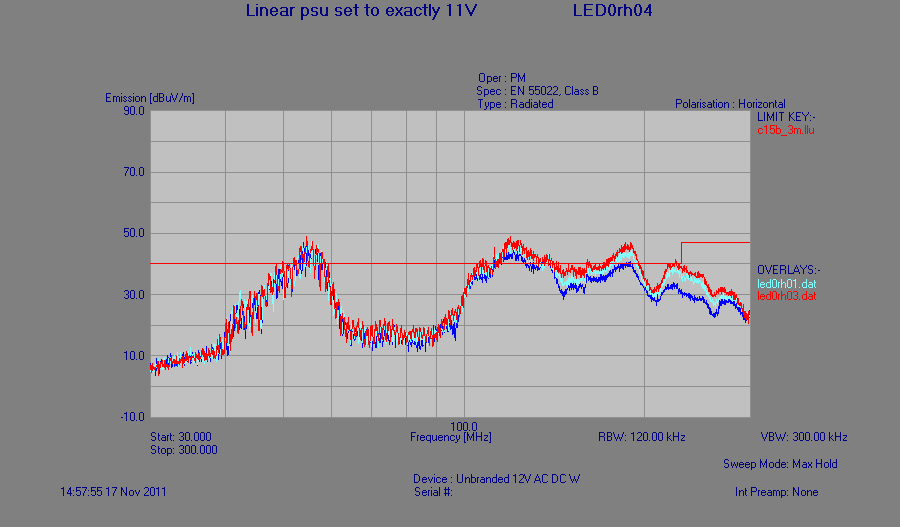
© METECC - Used with permission | Click the image for a larger view.
Conducted emissions with comparison overlays for voltages at 11V (blue trace), 12V (cyan trace) and 13V (red trace).
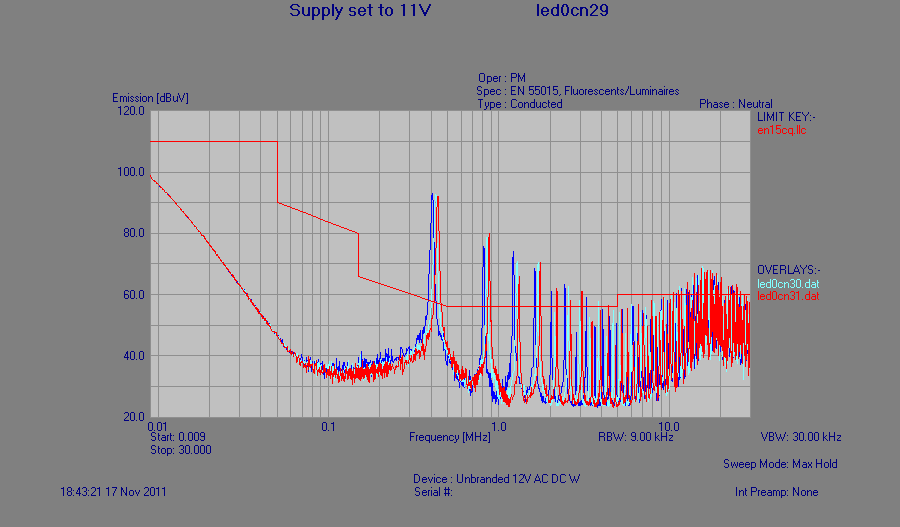
© METECC - Used with permission | Click the image for a larger view.
Deltech MR16 5W LED lamp
Radiated emissions with comparison overlays for voltages at 11V (blue trace), 12V (cyan trace) and 13V (red trace).
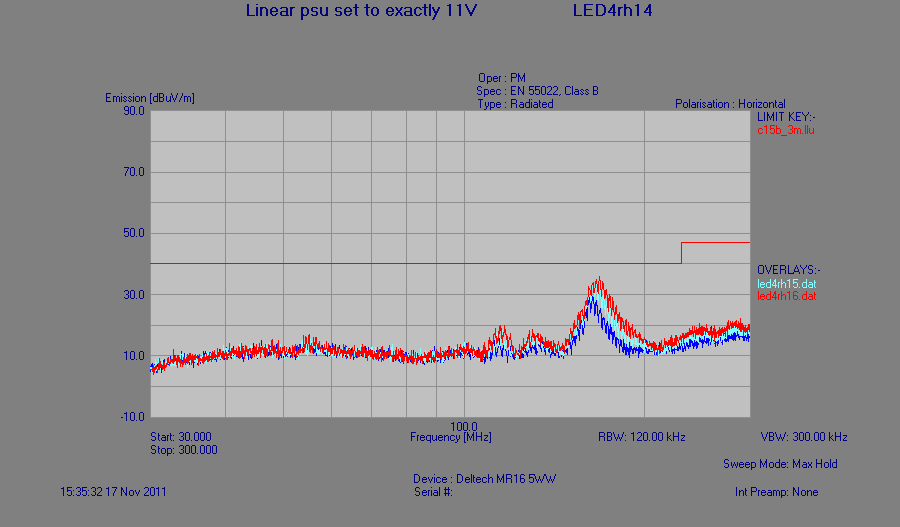
© METECC - Used with permission | Click the image for a larger view.
Conducted emissions with comparison overlays for voltages at 11V (blue trace), 12V (cyan trace) and 13V (red trace).
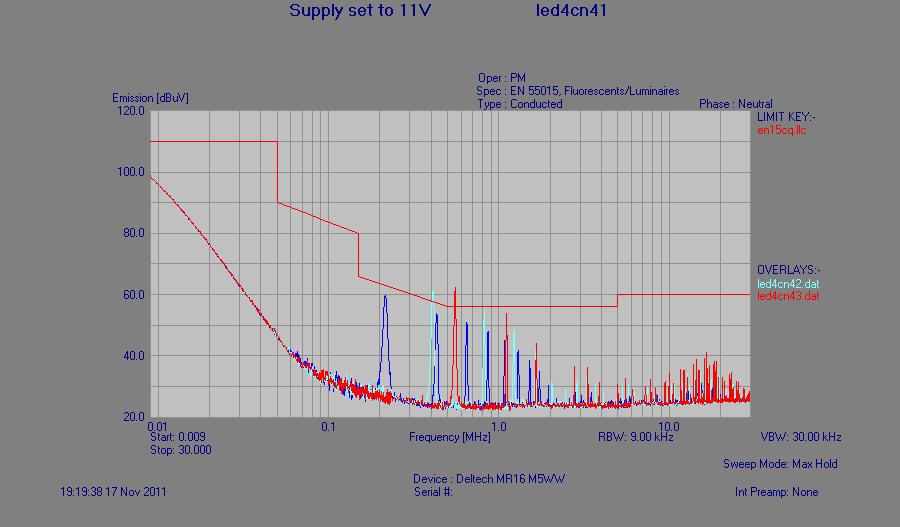
© METECC - Used with permission | Click the image for a larger view.
Philips 7W LED lamp
Radiated emissions with comparison overlays for voltages at 11V (blue trace), 12V (cyan trace) and 13V (red trace).
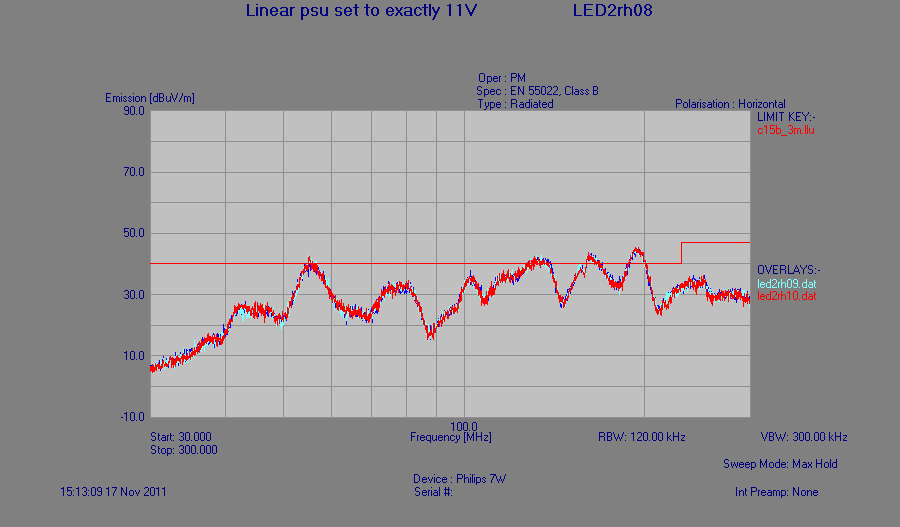
© METECC - Used with permission | Click the image for a larger view.
Conducted emissions with comparison overlays for voltages at 11V (blue trace), 12V (cyan trace) and 13V (red trace).
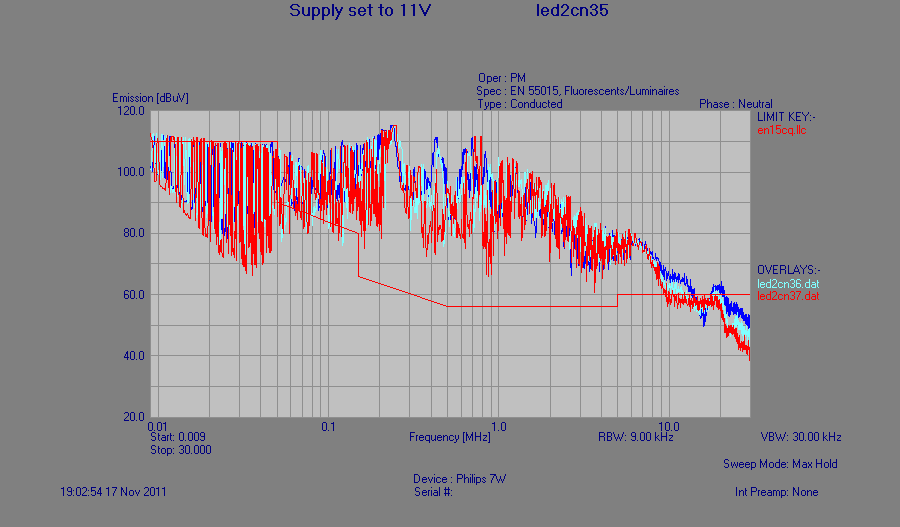
© METECC - Used with permission | Click the image for a larger view.
The critical voltage is not always the same!
Unbranded MR16 4W
Radiated emissions with comparison overlays for voltages at 11V (blue trace), 12V (cyan trace) and 13V (red trace).
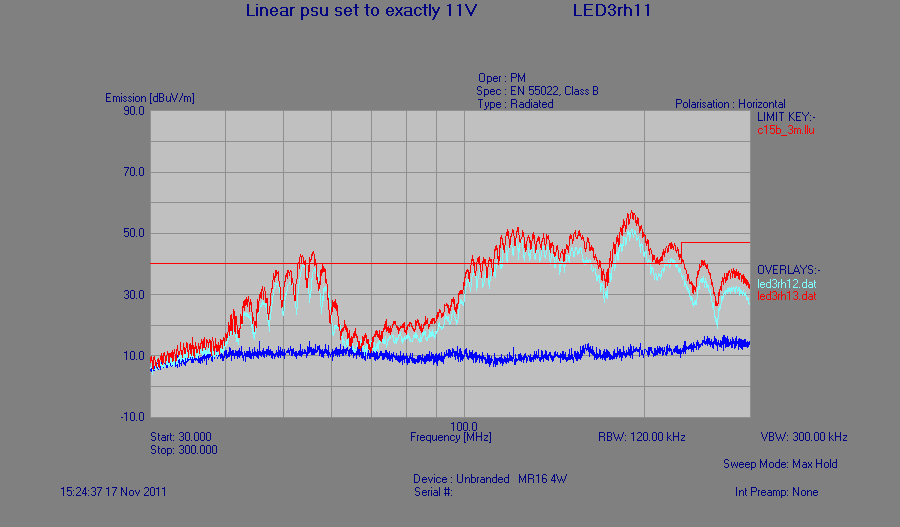
© METECC - Used with permission | Click the image for a larger view.
Unbranded MT16 6W
Radiated emissions with comparison overlays for voltages at 11V (blue trace), 12V (cyan trace) and 13V (red trace).
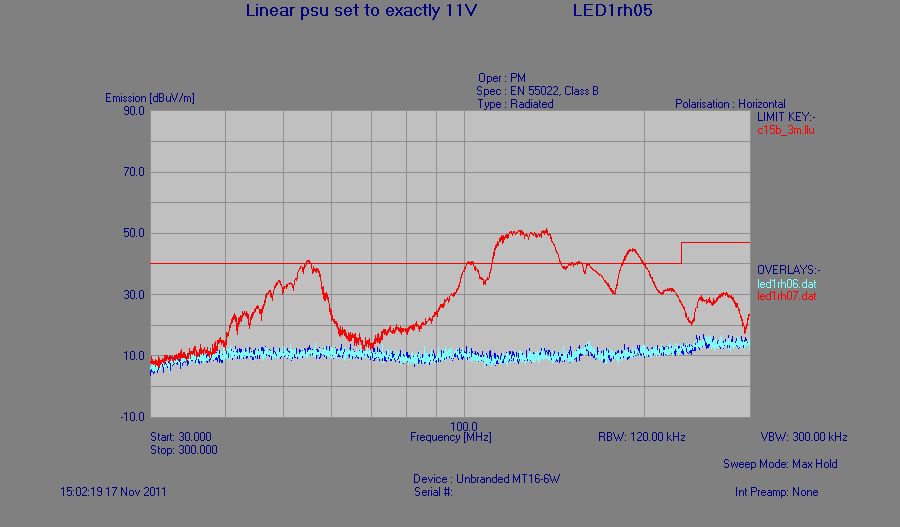
© METECC - Used with permission | Click the image for a larger view.
Does using AC voltages make a difference?
Unbranded MT16 6W
Conducted emissions with the voltage set to exactly 9Vac:
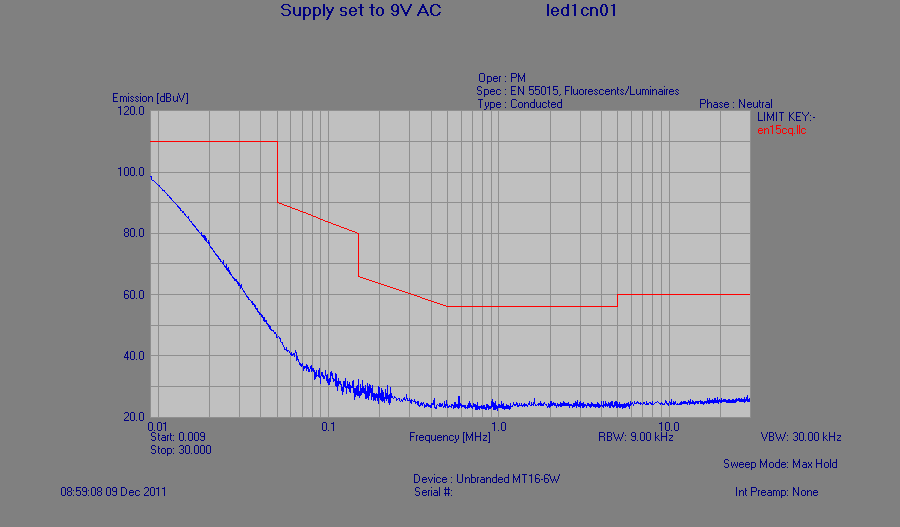
© METECC - Used with permission | Click the image for a larger view.
Conducted emissions with the voltage set to exactly 10Vac:
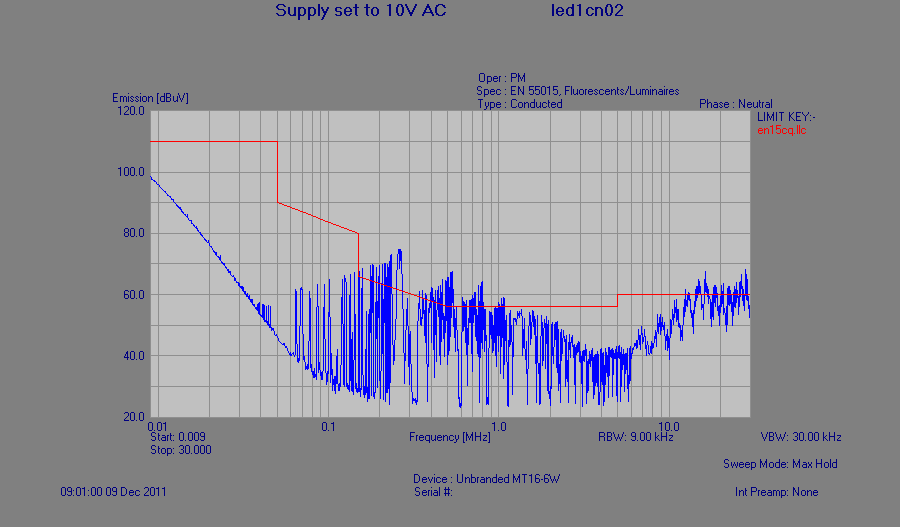
© METECC - Used with permission | Click the image for a larger view.
Conducted emissions with the voltage set to exactly 15Vac:
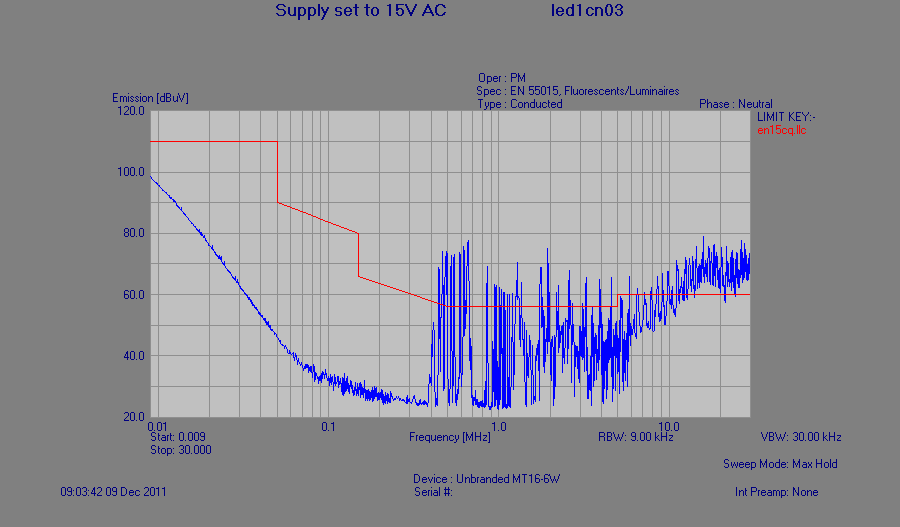
© METECC - Used with permission | Click the image for a larger view.
Conducted emissions with comparison overlays for voltages at 9Vac (red trace), 10Vac (cyan trace) and 15Vac (blue trace).
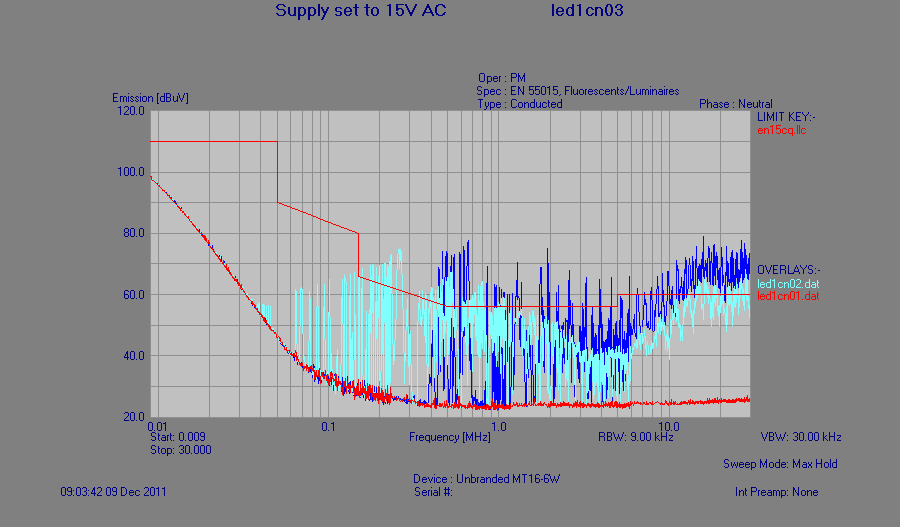
© METECC - Used with permission | Click the image for a larger view.
Philips 7W LED lamp
Conducted emissions with 2Vac (lamp just on)
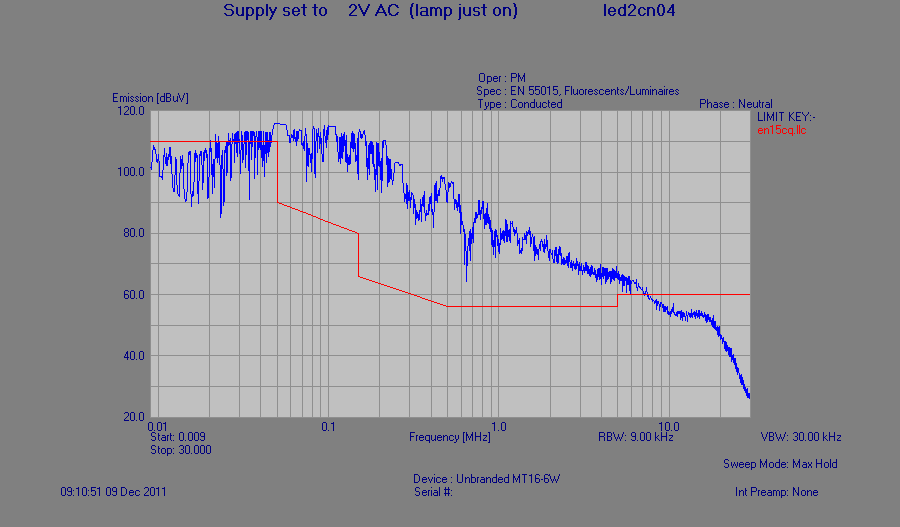
© METECC - Used with permission | Click the image for a larger view.
Conducted emissions 12Vac (rated voltage)
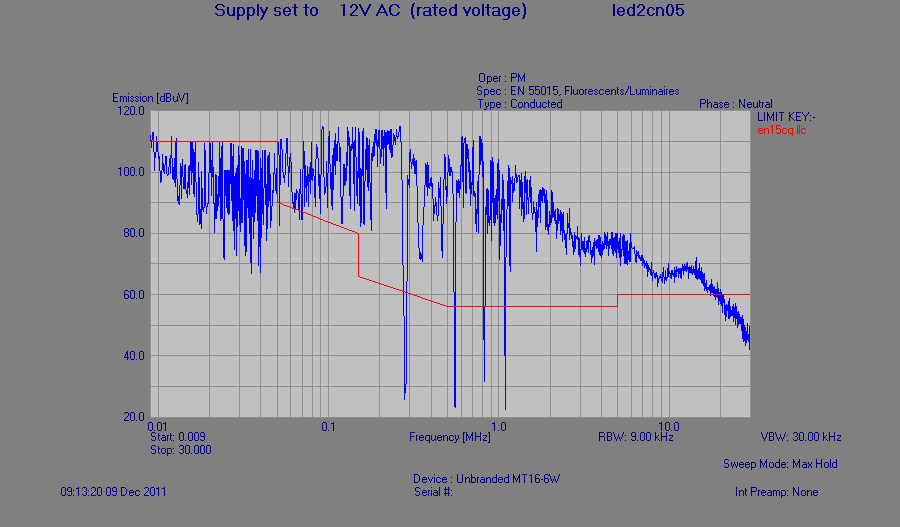
© METECC - Used with permission | Click the image for a larger view.
Conducted emissions 15Vac
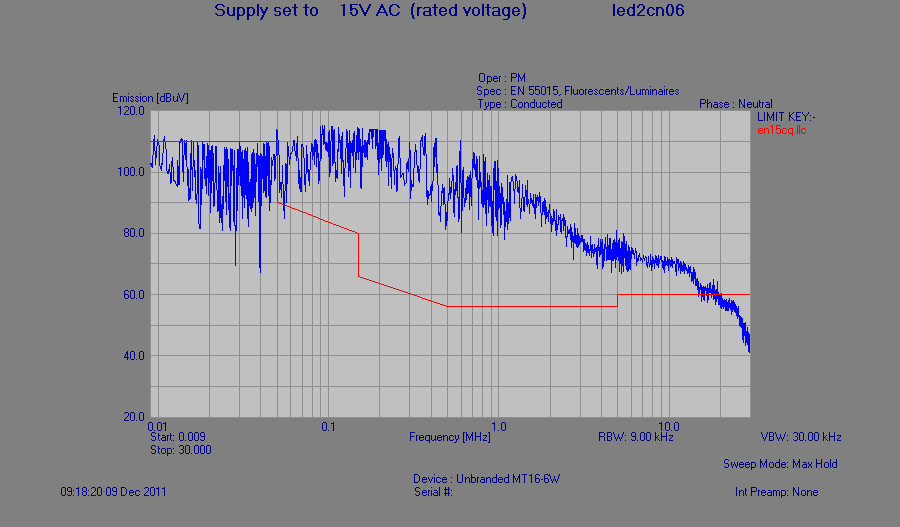
© METECC - Used with permission | Click the image for a larger view.
Conducted emissions with comparison overlays for voltages at 2Vac (red trace), 12Vac (cyan trace) and 15Vac (blue trace).
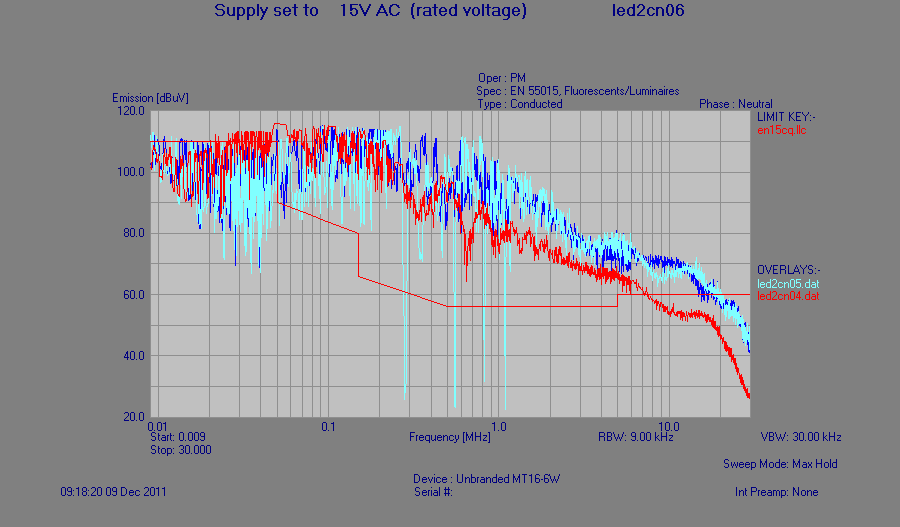
© METECC - Used with permission | Click the image for a larger view.
Unbranded MT16 4W
Conducted emissions 8Vac
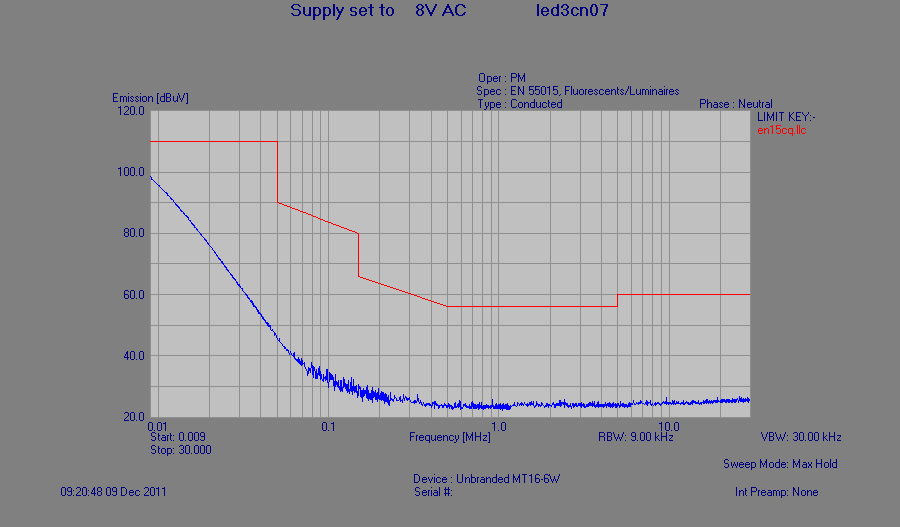
© METECC - Used with permission | Click the image for a larger view.
Conducted emissions 9Vac
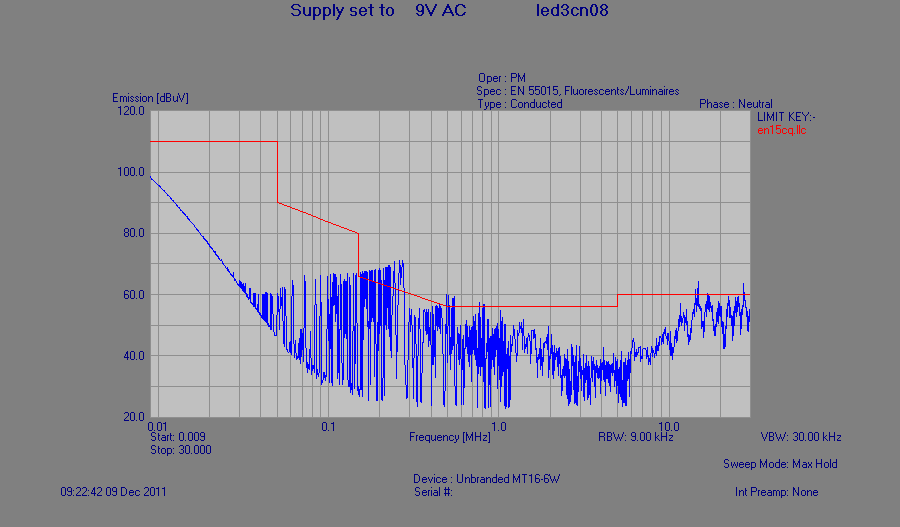
© METECC - Used with permission | Click the image for a larger view.
Conducted emissions 15Vac
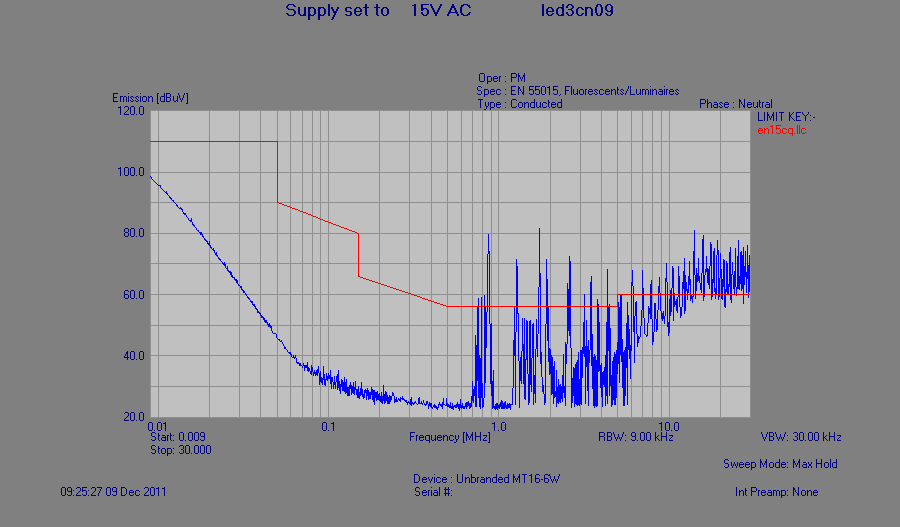
© METECC - Used with permission | Click the image for a larger view.
Conducted emissions with comparison overlays for voltages at 8Vac (red trace), 9Vac (cyan trace) and 15Vac (blue trace).
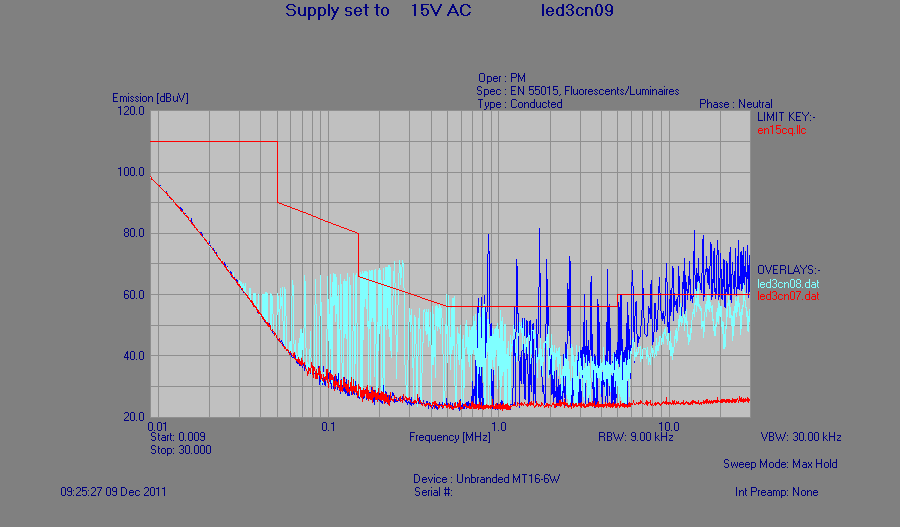
© METECC - Used with permission | Click the image for a larger view.
Philips 4W (from Keith Armstrong)
Conducted emissions 8Vac
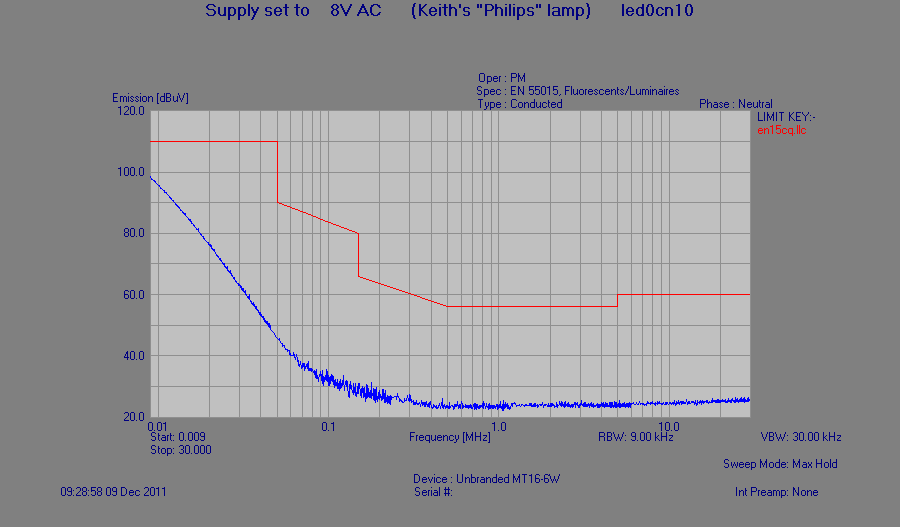
© METECC - Used with permission | Click the image for a larger view.
Conducted emissions 9Vac
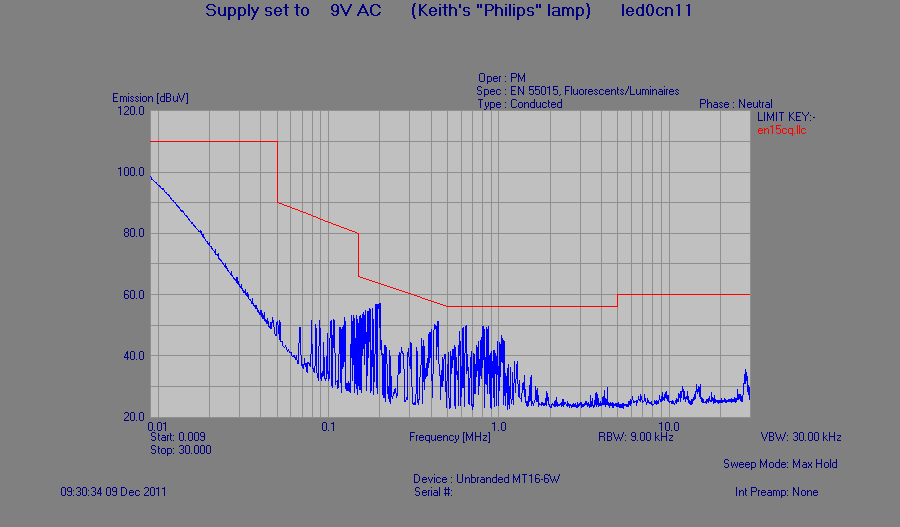
© METECC - Used with permission | Click the image for a larger view.
Conducted emissions 12Vac
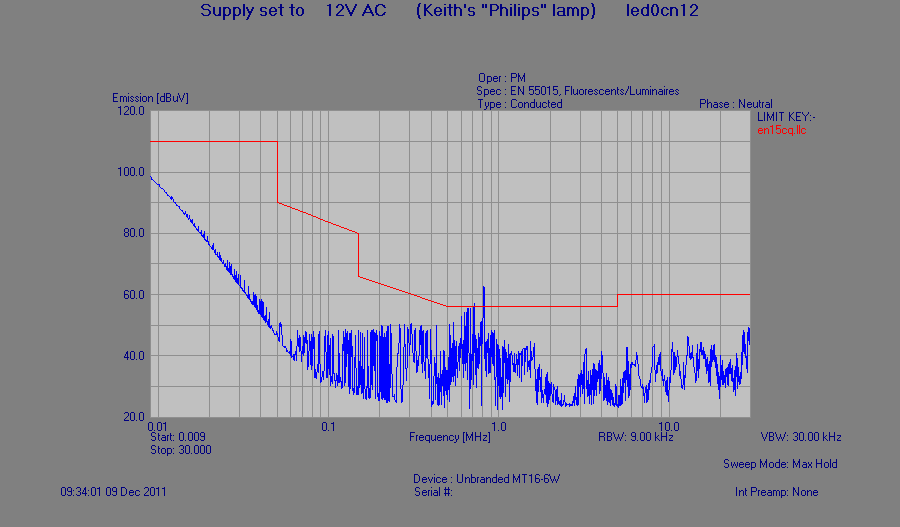
© METECC - Used with permission | Click the image for a larger view.
Conducted emissions 15Vac
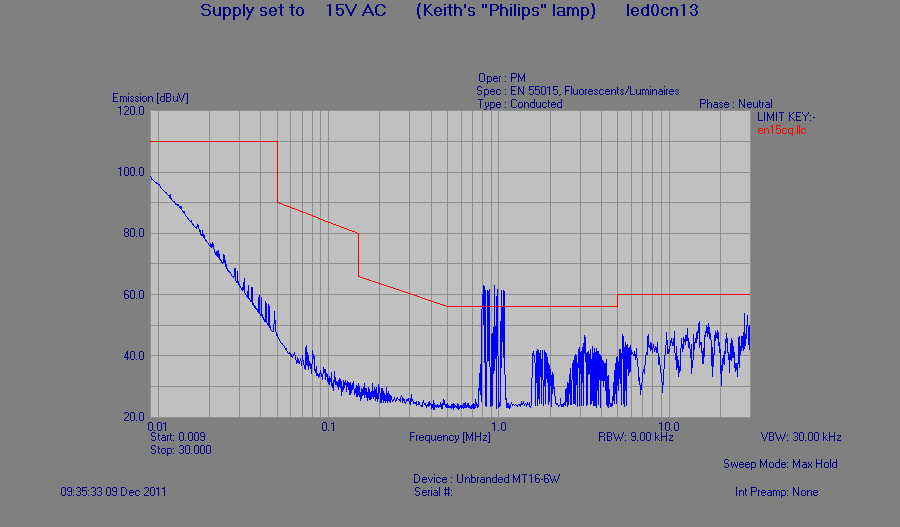
© METECC - Used with permission | Click the image for a larger view.
Conducted emissions with comparison overlays for voltages at 8Vac (black trace - noise-floor), 9Vac (red trace), 12Vac (cyan trace), and 15Vac (blue trace).
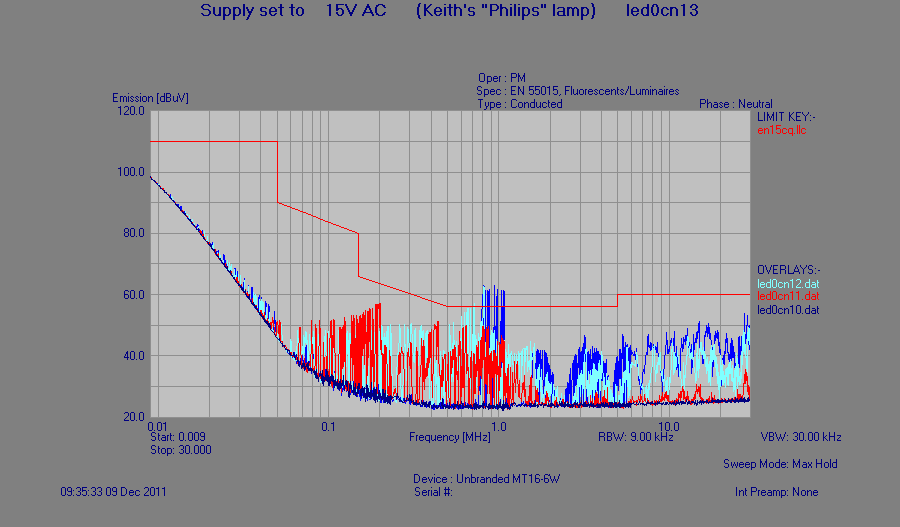
© METECC - Used with permission | Click the image for a larger view.
Conclusions of our investigations
METECC appreciate that the limit lines shown on some of the graphs are not strictly correct (CISPR22/EN55022 was used instead of CISPR15/EN55015) but it does not detract from the underlying problem of a lack of compliance to established EMC standards.
Subsequent to the original presentation of this piece, METECC have been informed that the official Ofcom/BBC position is that Ofcom have passed over all responsibility for investigation of broadcast radio interference matters to the BBC but have retained all aspects for prosecution for non-EMC-compliance. Therefore, we have the situation that:-
- One body has the remit to investigate but not prosecute
- A second body has the remit to prosecute but not investigate
The purchaser of CE-marked, non-EMC-compliant devices, appears to have no recourse to the law whilst the body in charge of enforcing EMC compliance (Ofcom) continues to ignore their statutory duties.
Page updated: 8th December 2020

Home | News | Legislation | Lighting | SMPS | Plasma | PLT | VDSL | Miscellaneous | Finding QRM | Your Story | Glossary | Contact your MP | Contact Us

